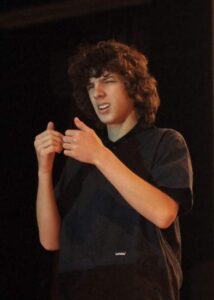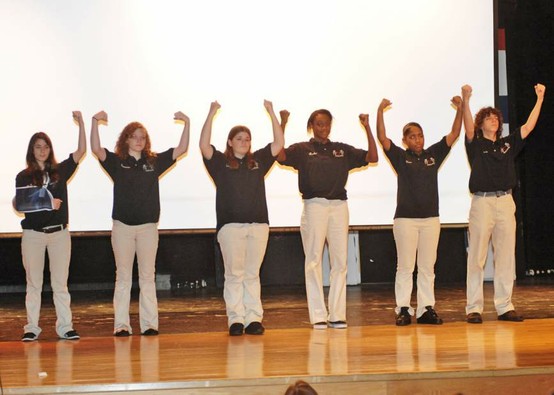In a single morning, North Hills Senior High School students got more than a glimpse into another world.
When students from the Western Pennsylvania School for the Deaf, or WPSD, visited to promote deafness awareness through a stage presentation, all six students of SignShine acted out a day in the life of their silent world.
With a narrator in the front row of the audience translating for the hearing audience, the teenagers signed their dialogue in skits parodying familiar TV shows. They communicated with each other using American Sign Language or ASL. In the audience, members of the ASL Club and the high school‘s ASL classes watched intently.
Every year, SignShine, which was created in 1995, returns to the high school stage by Barbara Drennen‘s invitation.
“I‘d have them every semester if I could,” she said.
Drennen, who has been teaching at North Hills for 21 of her 31 years, is the district‘s only ASL teacher. The ASL class began in the 1999-2000 school year because of a student‘s petition.
“The superintendent at the time, John Esaias, was so impressed that a student would take such initiative, he wanted it to happen,” said Drennen, of Shaler Township.
Having had a background in signing, she was asked to lead the class.
She first learned sign language when she was in the sixth grade.
“I had a classmate whose brother was deaf,” she remembered, “and her family was learning to sign. In the schoolyard, she taught some of us the alphabet and a few signs.”

Drennen then learned more from volunteer programs, noncredit classes and internships she had taken. Formal ASL classes at Community College of Allegheny County helped her to improve her skills. Then, she completed the ASL Studies Certificate Program at the University of Pittsburgh. Currently, she is engaged in earning national certification from the American Sign Language Teachers Association.
The ASL Club started in 2005 because of another student‘s interest.
“North Hills is one of about six high schools in the state that offer ASL as a language elective,” Drennen explained.
It isn‘t unusual for students to select ASL classes out of interest rather than need.
Marie McConnell, 15, a sophomore who lives in Ross Township, belongs to the ASL Club and plans to take the class in the future.
“It‘s a common courtesy. People should know a little (of the language),” she said.
“It‘s a way to be respectful.”
Courtney Baumgartner, 16, a junior who lives in Ross Township, switched to ASL when German became too difficult. She also belongs to the ASL Club.
“It‘s something different. It‘s a different opportunity,” she said.
“I know a few who sign.”
Ninth-grader Veeka Needham, 15, also of Ross Township, said she enjoys the fact that with ASL, a person uses the body to communicate.
And there‘s altruism behind her desire to learn the language.
“If somebody needed something, I could be a help to them,” she said.
Drennen applauds their efforts, as she does those of all her students.
“It‘s as difficult to become fluent in ASL as it is to learn Chinese or Arabic for English speakers,” she said.
But it all begins with a simple shaping of the hand to represent each letter of the alphabet.
That‘s how Jocelyn Demme, Melissa Shirk, Roché Tolbert, Kiara Rivera-Ramos, Summer Robinson and L.J. Morrone III of SignShine began the show, which was scripted by students. In later skits, they dispelled stereotypes about those who struggle with deafness.
People can be born deaf or become deaf through illness or injury. It is not hereditary. That deaf teens have the same hopes, dreams and problems that others their age do was one of the themes of the program.
Teens who are deaf like to watch television, have friends and date, drive cars and dine out in restaurants, and they want to have successful careers. Music can even be enjoyed by feeling its vibrations through the body.
Through sign language, lip reading and text, the deaf can communicate with anyone.
Cassie Beveridge is co-sponsor of the SignShine group, along with Erin Mascaro. Beveridge has taught at WPSD, which is in Edgewood, for 15 years.
“There are so many misconceptions about the deaf,” said Beveridge, citing a question she once had heard about whether the deaf used Braille.
“(The deaf) are avoided and picked on out of ignorance, but they have a full and beautiful language and communicate completely clearly.”
Her interest began at the University of Texas in Austin when a deaf professor encouraged her to take an ASL class. It was then she learned there was a need for teachers for the deaf.
“English is a second language to them,” Beveridge, of Oakmont, said.
“They struggle with reading and writing.”
Often, when deaf students are enrolled in public schools or mainstreamed, she explained, “they‘re not getting full sign language and not getting English. They must start with a full language base.”
Once open communication occur, “their whole world changes.”
With a sign, connections begin.
By Dona S. Dreeland
Published: Wednesday, December 26, 2012, 8:57 p.m.
Dona S. Dreeland is a staff writer for Trib Total Media. She can be reached at 724-772-6353 or ddreeland@tribweb.com.
